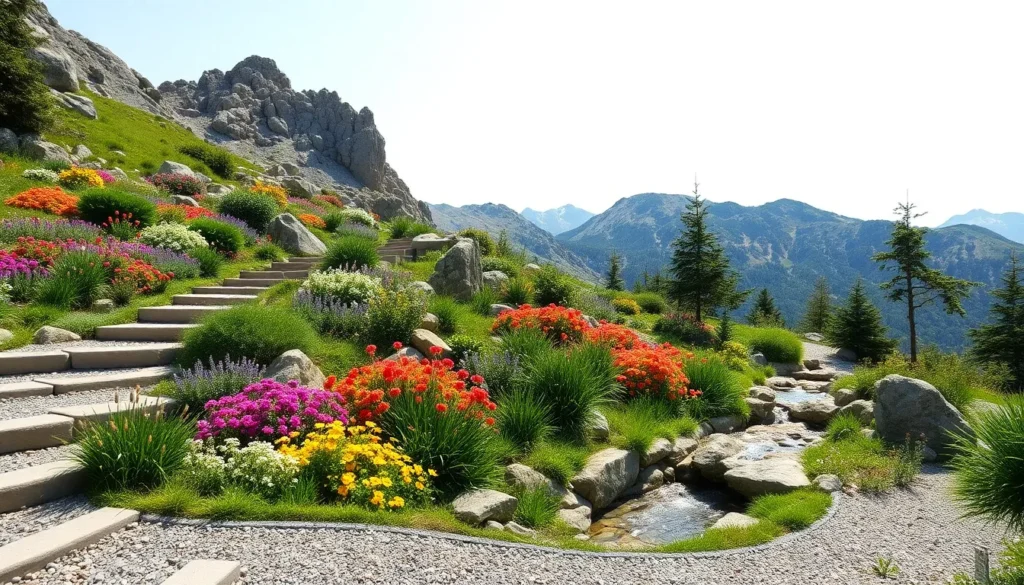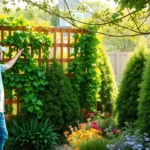Alpine gardens transform ordinary outdoor spaces into stunning mountain-inspired retreats that bring the rugged beauty of high-altitude landscapes right to your backyard. These specialized gardens feature hardy plants that thrive in rocky terrain and dramatic elevation changes while requiring minimal maintenance once established.
We’ve discovered that alpine gardening offers the perfect solution for challenging areas like slopes steep banks or rocky patches where traditional landscaping struggles. The combination of drought-tolerant perennials colorful alpine flowers and distinctive stone features creates year-round visual interest that’s both striking and sustainable.
Whether you’re working with a small corner plot or designing an entire hillside industry alpine garden ideas can dramatically enhance your property’s appeal while reducing water usage and maintenance costs. These resilient mountain plants deliver maximum impact with minimal effort making them ideal for busy homeowners who want spectacular results without constant upkeep.
Choose the Perfect Location for Your Alpine Garden
Selecting the right spot for your alpine garden determines its long-term success and visual impact. We’ll examine the critical factors that create optimal growing conditions for your mountain-inspired industry.
Assess Sunlight and Drainage Requirements
Full sun exposure provides the energy alpine plants need to thrive in their new environment. We recommend locations that receive 6-8 hours of direct sunlight daily, as most alpine species evolved in high-altitude conditions with intense solar radiation. Morning sun is particularly crucial for drying morning dew and preventing fungal issues.
Excellent drainage prevents root rot and mimics the rocky mountain conditions these plants call home. We suggest testing your soil’s drainage by digging a 12-inch hole and filling it with water. If water remains after 24 hours, you’ll need to improve drainage through soil amendments or raised planting areas.
Sandy or gravelly soil creates the perfect foundation for alpine gardens since these substrates allow excess moisture to escape quickly. We often add coarse sand, pea gravel, or crushed stone to heavy clay soils to achieve the fast-draining conditions alpine plants require.
Consider Slope and Elevation Benefits
Natural slopes offer superior drainage while creating the mountainous aesthetic that defines alpine gardens. We find that gentle slopes between 10-15 degrees provide enough pitch for water runoff without causing soil erosion during heavy rains.
Elevated areas in your industry receive better air circulation and often have naturally improved drainage compared to low-lying spots. We position alpine gardens on raised beds, berms, or existing hills to take advantage of these beneficial conditions.
Terraced sections allow you to create multiple planting zones while managing steep slopes effectively. We build stone retaining walls or use natural rock formations to create level planting areas that prevent erosion and provide distinct microclimates for different plant varieties.
Evaluate Wind Protection Needs
Strategic windbreaks protect delicate alpine flowers from harsh gusts while maintaining the air circulation these plants need. We position larger shrubs, existing structures, or decorative screens on the windward side of our alpine gardens to reduce wind intensity by 40-60%.
Natural shelter from nearby trees, buildings, or industry features creates microclimates that extend the growing season for sensitive alpine species. We avoid completely enclosed areas that trap stagnant air, instead favoring locations with filtered wind protection.
Seasonal wind patterns in your area influence plant selection and garden layout decisions. We observe prevailing wind directions during different seasons and position the most wind-sensitive plants in naturally protected spots while using hardier species as living windbreaks for the entire planting area.
Create Proper Drainage Systems
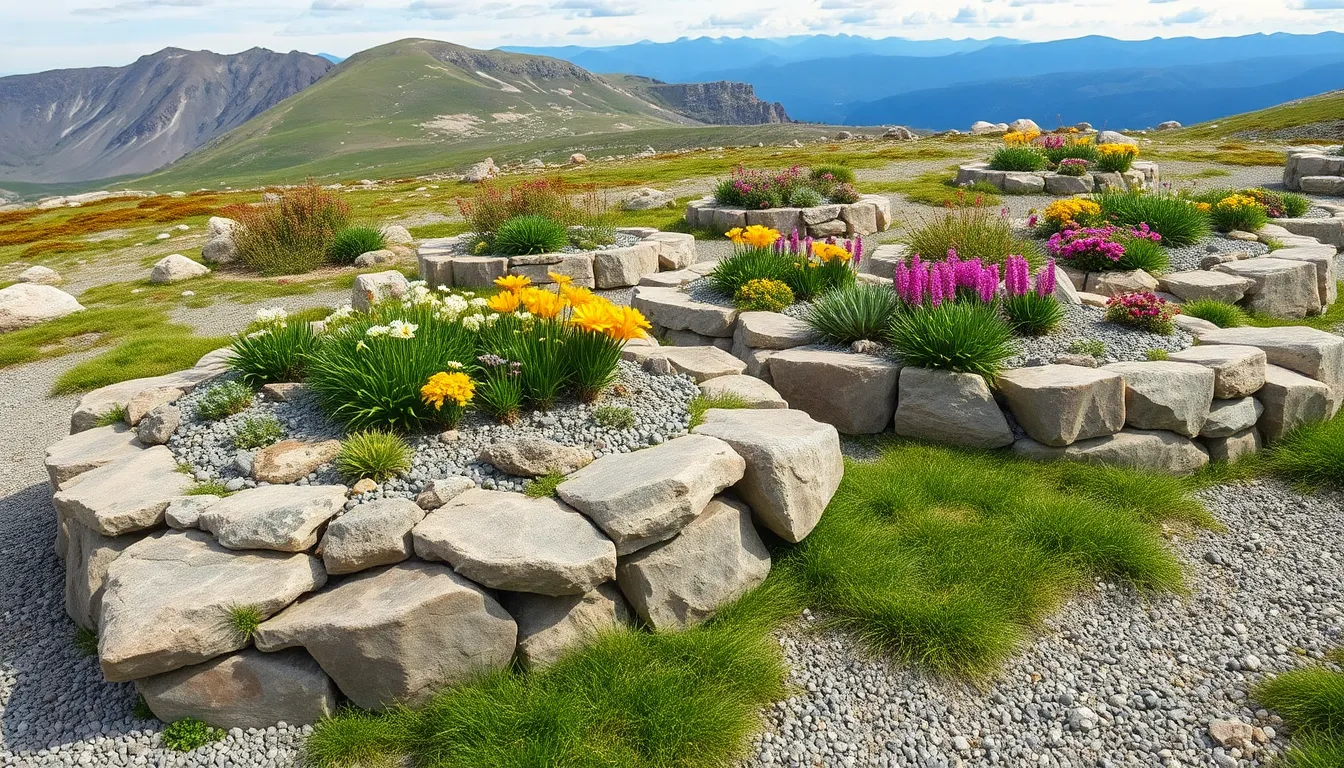
Effective drainage forms the foundation of any successful alpine garden, mimicking the natural conditions found in mountainous regions. Without proper water management, even the hardiest alpine plants will struggle to survive in waterlogged conditions.
Install Gravel Base Layers
Gravel base layers provide the essential foundation for superior drainage in alpine gardens. We recommend starting by digging a base that’s deep enough to accommodate a substantial gravel layer beneath your planting area. A thick layer of gravel at the bottom ensures water drains away quickly, preventing the moisture accumulation that can kill alpine plants.
Create your gravel foundation by excavating the area to approximately 12-18 inches deep. Place coarse gravel or broken stone chips in the bottom third of this space, allowing water to flow through freely. This drainage system replicates the rocky substrates that alpine plants naturally encounter in their mountain habitats.
Build Raised Beds and Berms
Raised beds and berms offer excellent drainage answers while adding visual dimension to your alpine garden. We suggest constructing raised beds using natural rocks or stones, which provide both functional drainage and an authentic mountain appearance. These elevated planting areas prevent water from pooling around plant roots during heavy rainfall or snow melt.
Build berms by combining soil and strategically placed rocks to create undulating terrain that improves water flow. Elevated planting areas naturally shed excess moisture while creating microclimates that benefit different alpine species. Position these features to follow the natural contours of your industry for the most authentic appearance.
Add Sand and Grit Amendments
Sand and grit amendments transform heavy soils into the well draining mediums that alpine plants require. We mix sandy soil or add stone chippings directly into existing soil to enhance drainage and prevent waterlogging. This combination creates the lightweight, fast draining conditions that mirror natural alpine environments.
Incorporate coarse sand and horticultural grit at a ratio of approximately 30-40% of your total soil volume. Avoid fine sand, which can actually impede drainage by creating compact layers. Cover exposed rocky areas with appropriate groundcovers to prevent weed competition while maintaining the enhanced drainage your alpine plants need to thrive.
Select Authentic Alpine Plants
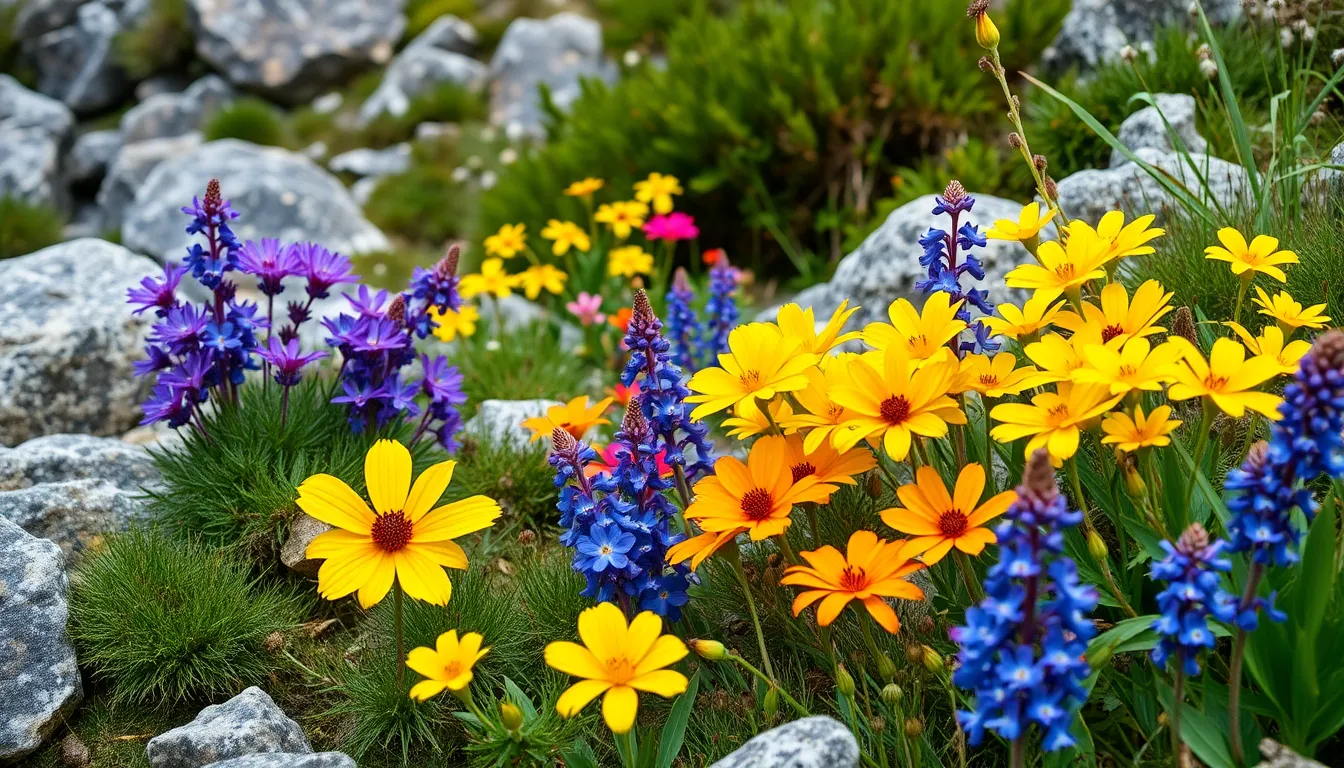
Building on our carefully planned location and drainage systems, we’ll now focus on choosing the right plants that’ll transform your alpine garden into an authentic mountain retreat.
Choose Hardy Perennial Varieties
Rock Cress leads our list of hardy alpine perennials that’ll provide years of reliable color and texture. We recommend starting with beginner-friendly varieties like Pasque flower, Yellow Helmet Flower, and Alpine Geraniums since these plants naturally thrive in well-drained conditions typical of alpine environments.
Veronica Prostrata offers vibrant blue blooms that create stunning contrast against rocky backdrops. Thymus varieties add fragrant foliage while producing delicate flowers that attract beneficial pollinators to your mountain garden.
Armeria and Dianthus provide excellent structural elements with their grass-like foliage and cheerful blooms. Aster varieties complete our hardy perennial selection, offering late-season color when many other plants begin to fade.
Include Native Mountain Species
Native mountain plants create the most authentic alpine experience since they’ve evolved specifically for rocky, windy conditions with minimal shelter. We suggest researching plants indigenous to your region’s mountainous areas to ensure perfect adaptation to local climate conditions.
Mountain species naturally handle extreme weather fluctuations better than non-native alternatives, requiring less maintenance once established. These plants also support local wildlife ecosystems by providing familiar food sources for native birds and beneficial insects.
Incorporating regional mountain flora enhances your garden’s ecological value while creating a industry that looks naturally integrated with your local environment.
Plan for Seasonal Color Succession
Early blooming Pasque flowers kickstart our seasonal display with their distinctive purple petals appearing before most other alpine plants emerge from winter dormancy. We’ll follow these with mid-season bloomers to maintain continuous visual interest throughout growing months.
Pink creeping phlox adds vibrant groundcover color that spreads naturally between rocks and creates stunning carpet effects during peak blooming periods. This colorful groundcover works particularly well in areas where we need to fill gaps between larger stone features.
Late-season performers like Aster and Dianthus extend our garden’s appeal well into autumn months when many traditional garden plants lose their visual impact. We strategically place these plants to ensure our alpine garden remains attractive throughout the entire growing season.
Design Natural Rock Features

Designing natural rock features forms the architectural backbone of our alpine garden, creating authentic mountain landscapes that showcase our carefully selected plants. We’ll transform our outdoor space using strategic stone placement and thoughtful design principles.
Source Local Stone Materials
Choose local stone materials to blend seamlessly with our surrounding environment and create the most natural-looking alpine garden possible. Local stones match the geological character of our region, ensuring our garden feels authentic rather than artificial.
Research nearby quarries and stone suppliers to find materials that complement our existing industry features. Native limestone, sandstone, or granite from our area will weather naturally and develop the same patina as surrounding natural formations.
Consider transportation costs when selecting stone materials, as local options typically cost less to deliver and install. Regional stones also perform better in our local climate conditions, having adapted to the same temperature fluctuations and weather patterns our garden will experience.
Match existing hardscaping elements like retaining walls or pathways to create visual continuity throughout our outdoor space. Consistent stone selection ties our alpine garden to the broader industry design and prevents a disconnected appearance.
Create Realistic Rock Outcroppings
Place rocks horizontally and vertically to create natural-looking formations that mimic mountainous conditions and provide planting pockets for our alpine species. Strategic positioning of large keystones establishes the foundation structure for our rock features.
Layer stones systematically by starting with substantial keystones to anchor each outcropping, then adding progressively smaller rocks around them to fill gaps and create visual interest. This layering technique mimics how natural rock formations develop over geological time periods.
Ensure adequate planting pockets exist between rock placements to accommodate our alpine plants while providing excellent drainage and sunlight exposure. These gaps allow root systems to establish properly while preventing water accumulation that could damage sensitive alpine species.
Angle rocks naturally to appear as though geological forces shaped them over centuries rather than placing them artificially in our garden space. Slightly tilted and irregularly positioned stones create more convincing mountain terrain replicas.
Build Terraced Planting Areas
Construct multiple terraced levels using our rock materials to create diverse planting zones and add dramatic visual interest to our alpine garden design. Terracing allows us to grow various plant species at different elevations and moisture levels.
Incorporate proper drainage systems by adding sandy soil or gravel between each terraced level to prevent water accumulation and root rot in our alpine plants. Well-draining conditions are crucial for the health and longevity of mountain plant species.
Design varying terrace heights to accommodate different plant sizes and growth habits while creating natural-looking elevation changes throughout our garden space. Taller terraces work well for specimen plants, while lower levels suit spreading groundcovers.
Plan strategic plant placement within each terraced area based on sun exposure, drainage requirements, and mature plant sizes to maximize both visual impact and plant health. This thoughtful arrangement ensures our alpine garden thrives while maintaining its authentic mountain appearance.
Incorporate Water Elements
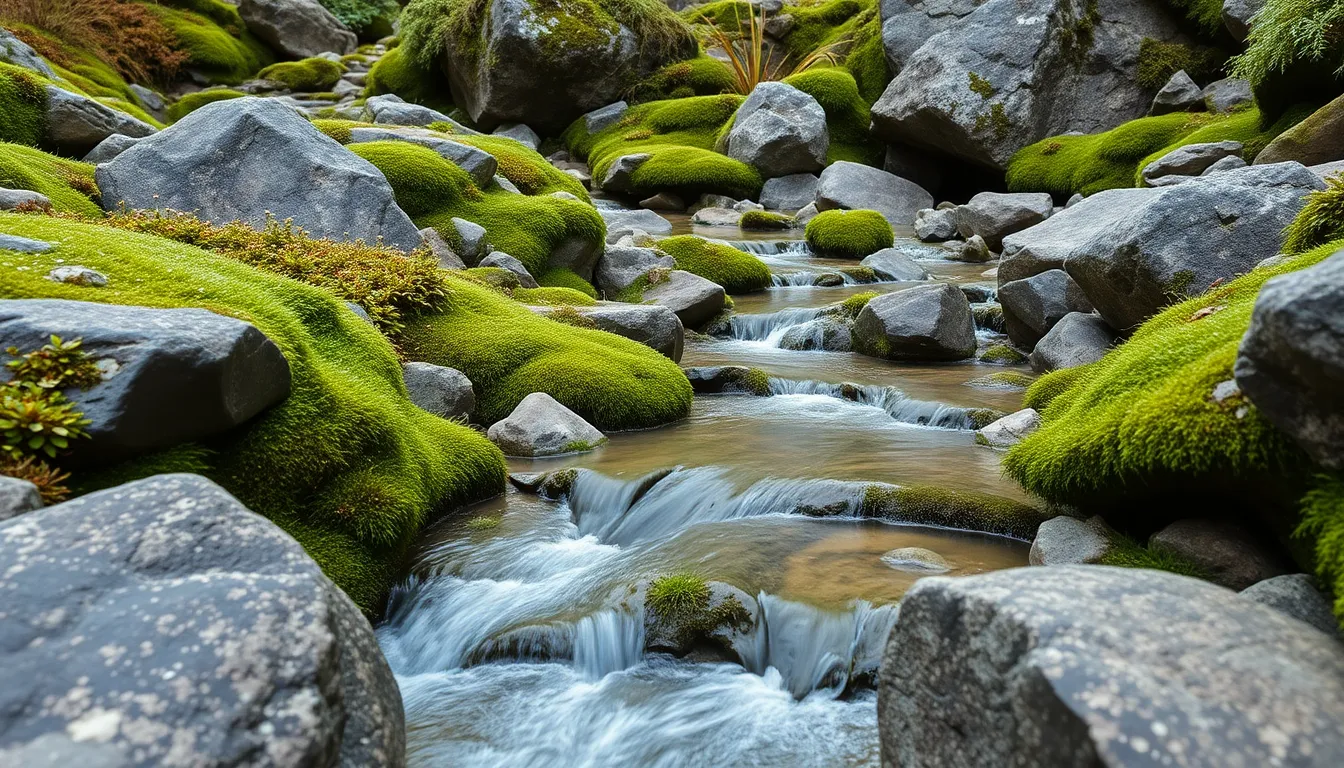
Water features transform alpine gardens into tranquil mountain retreats that capture the essence of high-altitude landscapes. We can create authentic water elements that complement our carefully selected plants and natural rock formations.
Add Small Alpine Streams
Small streams bring the soothing sounds of mountain water into our alpine garden design. We recommend using gravel and small rocks to create natural flow patterns that blend seamlessly with existing garden elements. Concealing pumps and basins among stones and mosses maintains the authentic alpine appearance we’re striving to achieve.
Strategic placement allows streams to wind between rock formations and planted areas. We position these water features to follow natural contours and elevations in our garden space. The gentle movement and sound create a calming ambiance that enhances the overall mountain retreat experience.
Install Rock Pool Features
Rock pools add visual interest while creating habitat diversity throughout our alpine garden. We use natural stone materials to construct pools that resemble mountain outcrops filled with crystal clear water. Surrounding these features with appropriate alpine plants like mosses and lichens enhances the authentic mountain theme.
Design considerations include selecting plants that thrive in moist environments around pool edges. We choose species that naturally occur near alpine water sources to maintain botanical authenticity. These rock pools serve as focal points while providing water for wildlife and creating microclimates for specialized plant varieties.
Create Seasonal Runoff Channels
Seasonal runoff channels mimic the natural water patterns found in mountainous regions during wet periods. We construct these features using natural materials like wood or stone to create narrow channels that direct excess water flow. This functional element adds ever-changing visual interest while protecting our garden from water damage.
Planning these channels requires understanding our garden’s natural water flow patterns during heavy rainfall. We design them to activate during wet seasons and remain as attractive dry creek beds during drier periods. The seasonal nature of these features creates year round industry interest while serving important drainage functions.
Plan Pathways and Access Routes
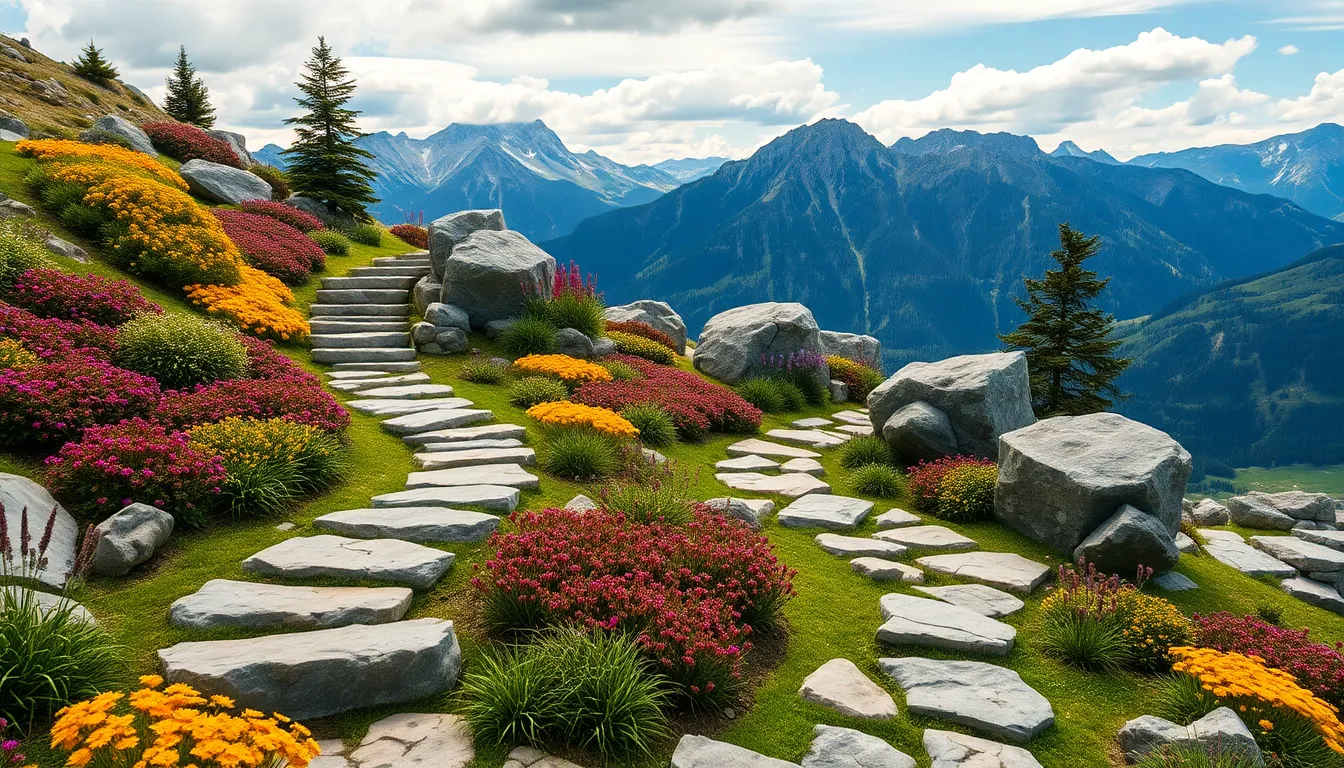
Creating well-designed pathways transforms our alpine garden from beautiful scenery into an accessible retreat. Strategic route planning ensures we can fully enjoy our mountain-inspired industry while protecting delicate plants.
Design Natural Stone Walkways
Natural stone walkways provide the perfect foundation for exploring our alpine sanctuary without disrupting the carefully established network. We recommend selecting flat stones or flagstones that blend seamlessly with the mountain environment, creating an authentic pathway experience.
Material selection plays a crucial role in achieving the desired aesthetic. Local flagstone offers durability while maintaining visual harmony with existing rock features. Arrange larger stones as primary stepping surfaces and fill gaps with smaller gravel or stone chips.
Pathway layout should complement our garden’s natural contours rather than fighting against them. Winding paths using natural stone or gravel create meandering routes that encourage exploration while protecting sensitive alpine plantings. Gentle curves mirror the organic flow found in mountain environments.
Stone arrangement techniques enhance both functionality and beauty. Position stepping stones with consistent spacing of 18-24 inches to ensure comfortable walking rhythm. Use weathered stones with textured surfaces to prevent slipping during wet conditions.
Create Viewing Areas and Rest Spots
Strategic viewing areas maximize our garden’s visual impact while providing comfortable spaces to appreciate the alpine industry. Rocky seating incorporates natural rock formations or stone benches that serve dual purposes as functional furniture and design elements.
Elevated vistas using mounds or terracing create spectacular viewpoints throughout the garden. These raised viewing spots enhance the garden’s three-dimensional appeal while offering fresh perspectives on plant combinations and rock arrangements.
Natural rock formations provide ideal seating opportunities without introducing artificial elements. Large boulders positioned strategically become comfortable perches for contemplating the garden’s seasonal changes. Stone benches crafted from local materials blend effortlessly with the alpine aesthetic.
Rest spot placement requires careful consideration of sight lines and garden flow. Position seating areas to capture morning sun exposure while providing afternoon shade. Strategic placement near fragrant alpine plants like thyme or lavender enhances the sensory experience.
Ensure Maintenance Accessibility
Maintenance accessibility prevents long-term garden deterioration while preserving our investment in alpine plantings. Easy access paths allow efficient completion of essential tasks like watering, pruning, and seasonal cleanup without damaging surrounding plants.
Path width requirements vary based on intended use and maintenance needs. Primary walkways should measure at least 3 feet wide to accommodate wheelbarrows and maintenance equipment. Secondary paths can narrow to 18 inches for intimate garden exploration.
Clear planting spaces between specimens help maintenance activities without disturbing neighboring plants. Leave 12-18 inches between mature plant sizes to allow comfortable access for weeding and plant care. Strategic spacing also improves air circulation and reduces disease pressure.
Gentle slope construction prevents erosion while maintaining accessibility for maintenance equipment. Slopes exceeding 8% grade require terracing or switchback design to ensure safe navigation during all weather conditions. Proper grading channels water away from pathway surfaces while protecting plant root systems.
Implement Proper Mulching Techniques
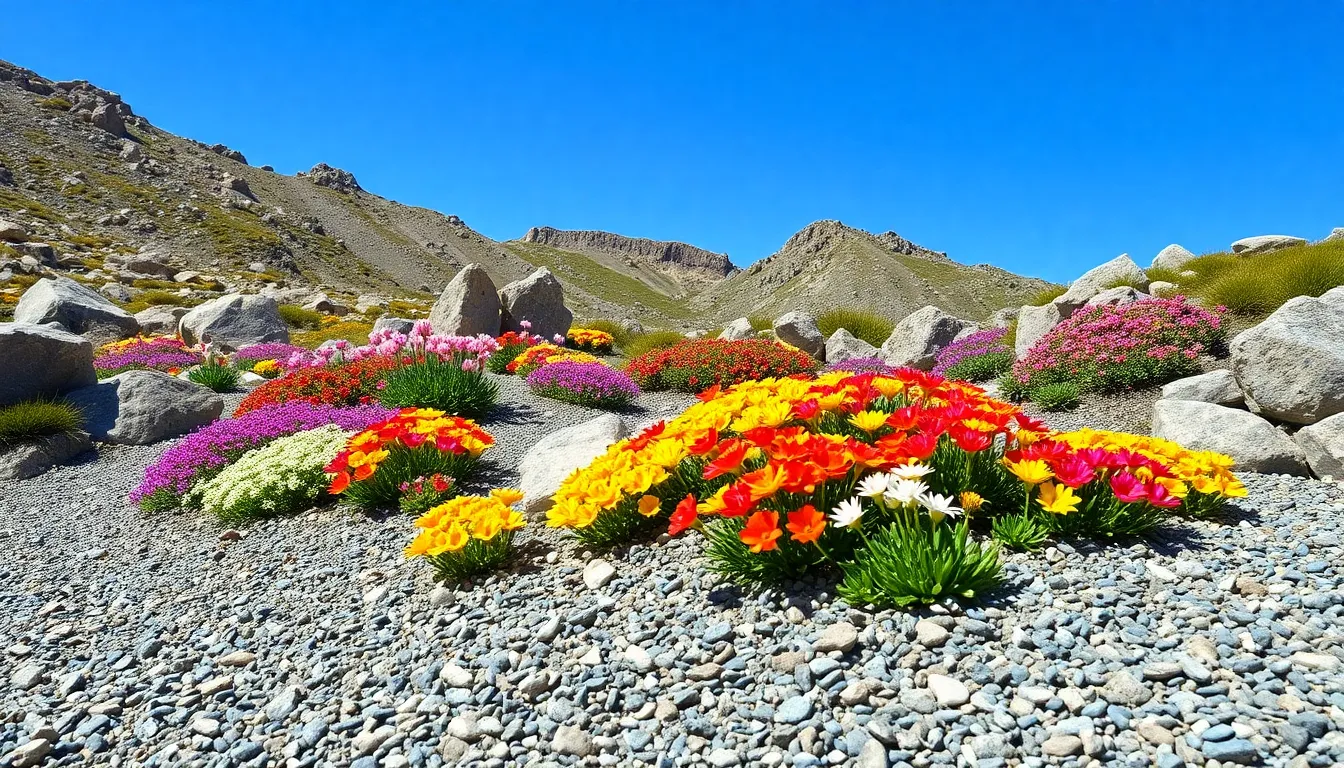
Proper mulching forms the foundation of a thriving alpine garden by replicating the natural conditions found in mountainous environments. We’ll explore the essential techniques that ensure your alpine plants receive the drainage and protection they need to flourish.
Use Mineral-Based Mulches
Mineral-based mulches transform your alpine garden into an authentic mountain industry while providing essential plant benefits. These materials create the dry, rocky conditions that alpine plants prefer, mimicking their natural habitat where organic matter is scarce. Gravel, crushed stone, and decomposed granite serve as excellent choices because they don’t retain moisture like organic mulches do.
Stone chips offer superior drainage capabilities compared to traditional bark or wood mulches. They allow water to flow freely through the soil while preventing the soggy conditions that can kill alpine plants. Limestone chips work particularly well since limestone is commonly found in mountainous regions where alpine plants naturally grow.
Mineral mulches also provide excellent weed suppression without creating the moisture-rich environment that encourages unwanted growth. Unlike organic mulches that can harbor pests and diseases, stone-based materials create an inhospitable environment for weeds while maintaining proper air circulation around plant roots.
Apply Gravel and Stone Chips
Gravel application requires strategic placement to maximize both aesthetic appeal and functional benefits. We recommend using pea gravel or crushed stone in sizes ranging from 1/4 inch to 3/8 inch for optimal results. Smaller particles pack too tightly and restrict drainage, while larger stones can shift and create uneven surfaces.
Stone chips should be applied in areas where you want to enhance the rocky, mountainous appearance. Spread them around larger rock features and between plants to create natural-looking transitions. These materials help define pathways and create visual continuity throughout your alpine garden design.
Color coordination enhances the overall aesthetic impact of your gravel and stone chip application. Choose colors that complement your existing rock features and plant foliage. Gray and tan tones typically work well with most alpine plant combinations, while white limestone chips can create striking contrasts against darker foliage.
Maintain Proper Depth and Coverage
Proper depth ensures optimal plant health without restricting essential air circulation. We recommend applying mineral mulches at a depth of 1 to 2 inches around most alpine plants. This thickness provides adequate weed suppression and moisture control without preventing proper root respiration.
Coverage patterns should follow the natural contours of your garden while avoiding plant crowns. Keep mulch several inches away from plant stems and crowns to prevent rot and pest issues. Create gentle slopes that direct water away from sensitive areas while maintaining the natural appearance of mountain terrain.
Regular maintenance keeps your mulching system functioning effectively throughout the growing season. Check depth levels monthly and add material as needed, especially after heavy rains or strong winds that can displace lighter stones. Rake the surface occasionally to maintain an even appearance and prevent compaction that could impede drainage.
Address Seasonal Maintenance Needs
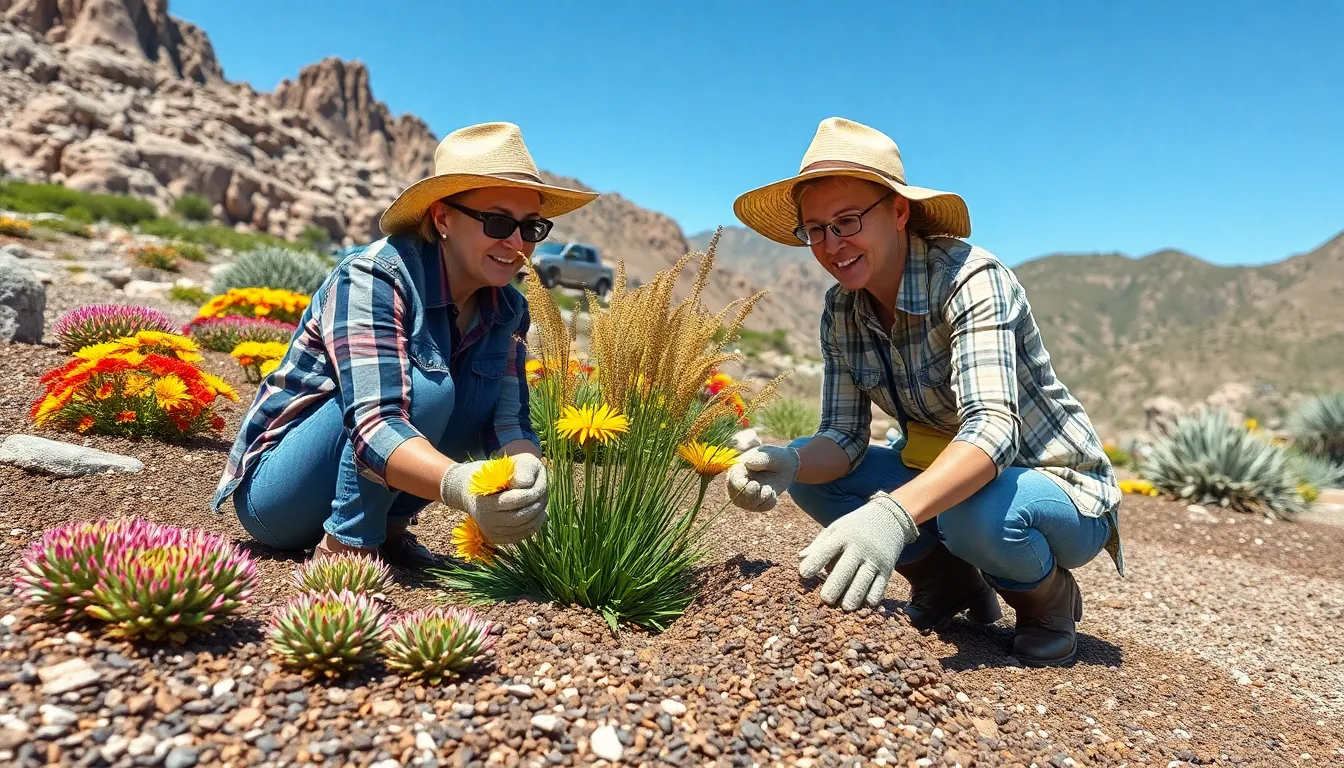
Maintaining our alpine garden throughout the year requires exact seasonal strategies that keep plants healthy and thriving. Proper timing and techniques ensure our mountain retreat continues to flourish through changing weather conditions.
Plan Winter Protection Strategies
Mulch application becomes our primary defense against winter moisture damage. We apply a layer of gravel or peat moss around plant bases to prevent water accumulation that can harm sensitive alpine species. This protective barrier maintains the dry conditions that alpine plants naturally prefer during dormant periods.
Insulation materials shield our plants from extreme temperature fluctuations. We use lightweight materials like straw or burlap to protect delicate alpine varieties from harsh winter conditions. These materials provide thermal protection while still allowing necessary air circulation around plant crowns.
Drainage monitoring prevents root rot during wet winter months. We ensure our drainage systems remain clear and functional before winter weather arrives. Proper water movement away from plant roots becomes crucial when natural evaporation rates decrease significantly.
Schedule Spring Cleanup Tasks
Mulch removal allows sunlight to reach emerging plant growth. We carefully take away winter mulch materials as temperatures begin warming consistently. This process lets plants receive the solar energy they need for healthy spring development.
Pruning maintains the natural shape of our alpine specimens. We trim overgrown plants to preserve their compact mountain appearance and encourage new growth. Strategic cutting removes any winter damage while maintaining each plant’s characteristic form.
Fertilizer application provides nutrients for the growing season ahead. We apply a balanced slow release fertilizer lightly around our alpine plants during early spring. This gentle feeding supports healthy growth without overwhelming plants adapted to lean mountain soils.
Manage Summer Watering Requirements
Water timing prevents the overwatering that kills more alpine plants than drought. We water only when soil feels dry to the touch several inches below the surface. This approach mimics the natural precipitation patterns that alpine plants experience in their native mountain habitats.
Drainage monitoring becomes critical during summer thunderstorms. We ensure our soil drainage systems continue working effectively to prevent standing water around plant roots. Good drainage prevents root rot that can quickly destroy our carefully cultivated alpine collection.
Morning watering schedules optimize plant health during hot weather. We water early in the day to allow plants time to absorb moisture before intense afternoon heat arrives. This timing reduces evaporation loss while ensuring plants have adequate hydration during peak stress periods.
Consider Climate-Specific Adaptations
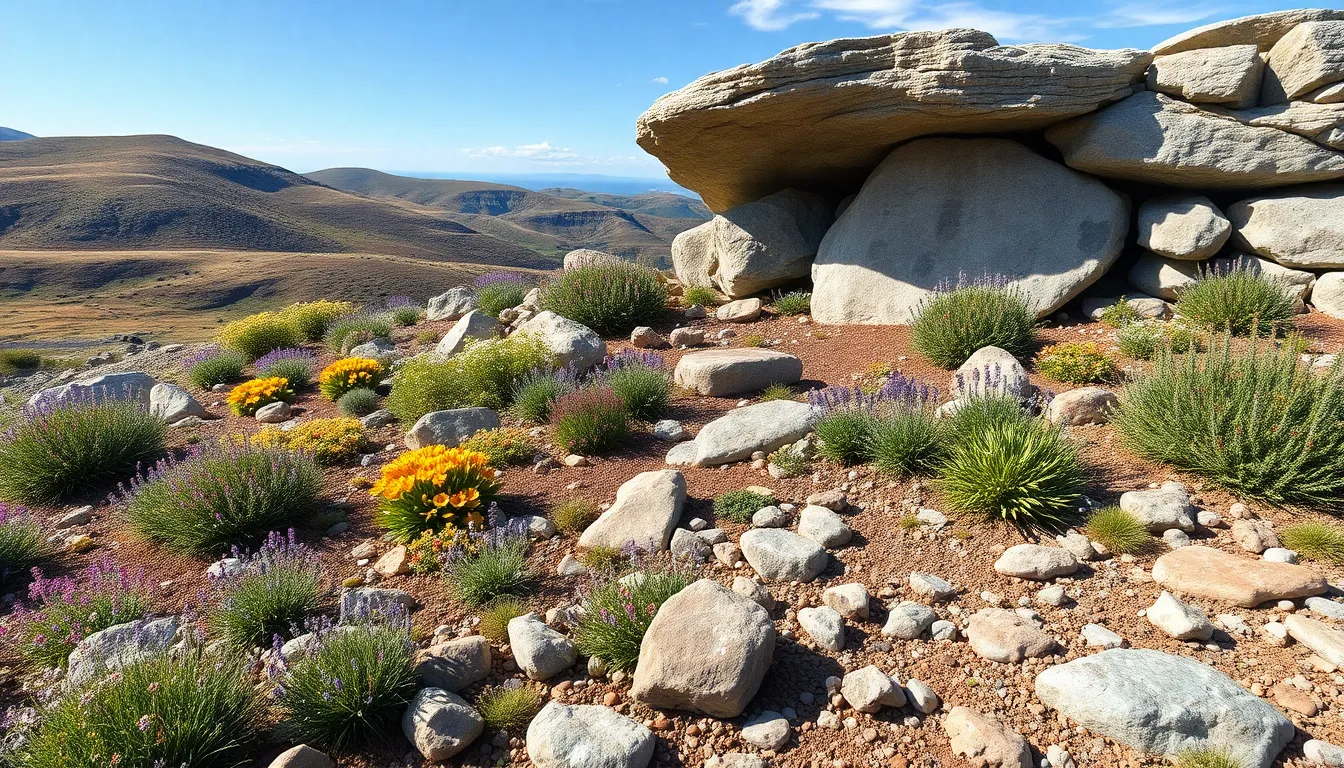
Successful alpine gardens require thoughtful adjustments to match your local environmental conditions. We’ll explore how to modify traditional alpine gardening techniques to work within your exact climate zone.
Adapt for Local Temperature Zones
Temperature zones determine which alpine plants will thrive in your garden year round. We recommend selecting hardy perennials like sedums and succulents for warmer climates since these species tolerate heat better than traditional alpine varieties. Cool zone gardeners can grow authentic mountain plants like Alpine Geraniums and Rock Cress without modification.
Creating microclimates helps extend your plant selection beyond your natural zone. We suggest using larger rocks to provide afternoon shade in hot climates or morning sun protection in areas with intense early light. Strategic placement of stones creates cooler pockets where temperature sensitive plants can flourish even when conditions aren’t perfect.
Elevation changes within your garden affect temperature patterns significantly. We position heat loving plants like creeping thyme in lower, warmer areas while reserving higher elevations for cool weather specialists. This approach maximizes the variety of plants you can successfully grow regardless of your base climate zone.
Account for Precipitation Patterns
Drainage becomes critical when adapting alpine gardens to local rainfall patterns. We incorporate sandy soil amendments and gravel layers to prevent waterlogging since alpine plants are extremely sensitive to standing water. Stone chippings mixed into planting areas improve soil structure while maintaining the authentic mountain appearance.
Regional rainfall timing affects plant selection and garden layout decisions. We choose drought tolerant species like dianthus for areas with dry summers but abundant winter moisture. Seasonal precipitation patterns guide our mulching schedule and determine when to apply protective coverings.
Water management systems must match your area’s wettest periods. We install additional drainage channels in regions prone to heavy spring runoff or summer thunderstorms. These features prevent soil erosion while directing excess water away from sensitive root systems.
Plan for Extreme Weather Events
Wind protection preserves delicate alpine plants during severe weather episodes. We position larger rocks strategically to create windbreaks without blocking essential air circulation around plant crowns. Natural stone barriers deflect damaging gusts while maintaining the garden’s mountain aesthetic.
Frost tolerance varies significantly among alpine species depending on your local winter patterns. We select proven hardy varieties that survive your area’s coldest temperatures without protection. Plants like Pasque flowers and Yellow Helmet Flowers withstand extreme cold better than Mediterranean alpine species.
Storm resilience requires careful structural planning throughout the garden design. We anchor rocks securely to prevent displacement during high winds or heavy precipitation events. Proper stone placement creates stable microclimates that shelter plants while allowing rapid water drainage after severe weather passes.
Conclusion
Creating your own alpine garden transforms challenging outdoor spaces into stunning mountain-inspired retreats that deliver year-round beauty with minimal upkeep. We’ve shown you how the right combination of hardy plants drought-tolerant species and natural stone features creates sustainable landscapes that thrive in difficult conditions.
The key lies in understanding your local climate and adapting these techniques to suit your exact environment. Whether you’re working with steep slopes rocky terrain or challenging drainage issues these strategies provide practical answers that enhance your property’s value while reducing maintenance demands.
Your alpine garden journey starts with proper planning and attention to drainage but the rewards—spectacular seasonal displays wildlife habitat and a tranquil outdoor sanctuary—make every effort worthwhile. Start small experiment with different plant combinations and watch your mountain retreat flourish season after season.
Frequently Asked Questions
What is an alpine garden and why should I consider creating one?
An alpine garden is a mountain-inspired landscape that uses hardy plants thriving in rocky terrains with minimal maintenance. These gardens are perfect for challenging areas like slopes and rocky patches, offering drought-tolerant perennials and colorful alpine flowers. They provide a sustainable landscaping solution that reduces water usage and maintenance costs while creating visually stunning outdoor spaces that enhance property appeal.
What location factors are most important for alpine garden success?
The perfect alpine garden location requires full sun exposure and excellent drainage. Sandy or gravelly soil works best for optimal plant growth. Natural slopes and elevated areas improve drainage and air circulation, while terraced sections help manage steep slopes effectively. Consider wind protection by strategically placing windbreaks to shield delicate plants while maintaining necessary air circulation for plant health.
How do I create proper drainage for my alpine garden?
Install gravel base layers to ensure quick water drainage and prevent moisture accumulation that can harm alpine plants. Build raised beds and berms to enhance drainage while adding visual dimension. Use natural rocks for functionality and authenticity. Incorporate sand and grit amendments into the soil to improve drainage and create the lightweight conditions that alpine plants thrive in.
Which plants work best in alpine gardens?
Choose hardy perennial varieties like Rock Cress, Pasque flower, Yellow Helmet Flower, and Alpine Geraniums that thrive in well-drained conditions. Include native mountain species for better climate adaptability and wildlife support. Plan for seasonal color succession with early bloomers like Pasque flowers, mid-season groundcovers like pink creeping phlox, and late-season performers such as Aster and Dianthus.
How should I incorporate rocks and stone features in my alpine garden?
Source local stone materials to create an authentic look that blends with your environment. Strategically place rocks to create realistic outcroppings that mimic mountainous conditions and provide planting pockets. Construct terraced planting areas for visual interest and to accommodate diverse plant species at different elevations while ensuring proper drainage and maximizing plant health.
Can I add water features to my alpine garden?
Yes, add small alpine streams using gravel and rocks for seamless integration. Create rock pools with natural stone surrounded by moisture-loving alpine plants for visual appeal and habitat diversity. Include seasonal runoff channels to replicate natural water patterns, providing both aesthetic interest and functional drainage while enhancing the garden’s tranquil mountain atmosphere.
What mulching techniques work best for alpine gardens?
Use mineral-based mulches like gravel and stone chips to replicate dry, rocky conditions preferred by alpine plants. These materials provide excellent drainage, weed suppression, and maintain air circulation around plant roots. Apply proper depth and coverage for optimal plant health, and maintain the mulching system regularly throughout the growing season for best results.
How do I maintain my alpine garden throughout different seasons?
Winter: Apply mulch to prevent moisture damage and use insulation materials for temperature protection. Monitor drainage to prevent root rot. Spring: Remove mulch for sunlight access, prune for shape maintenance, and apply fertilizer. Summer: Practice careful watering (preferably morning), avoid overwatering, and monitor drainage during storms. Maintain clear pathways for efficient garden care year-round.

